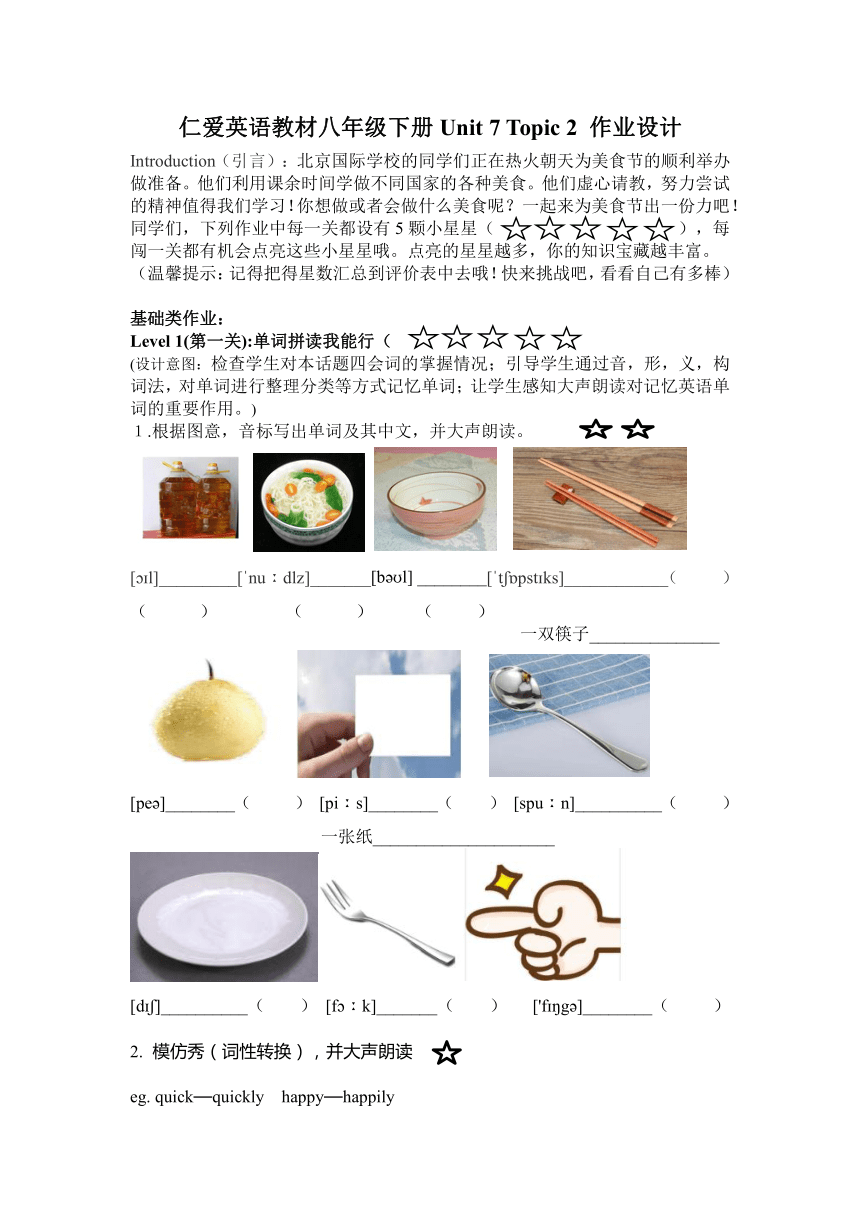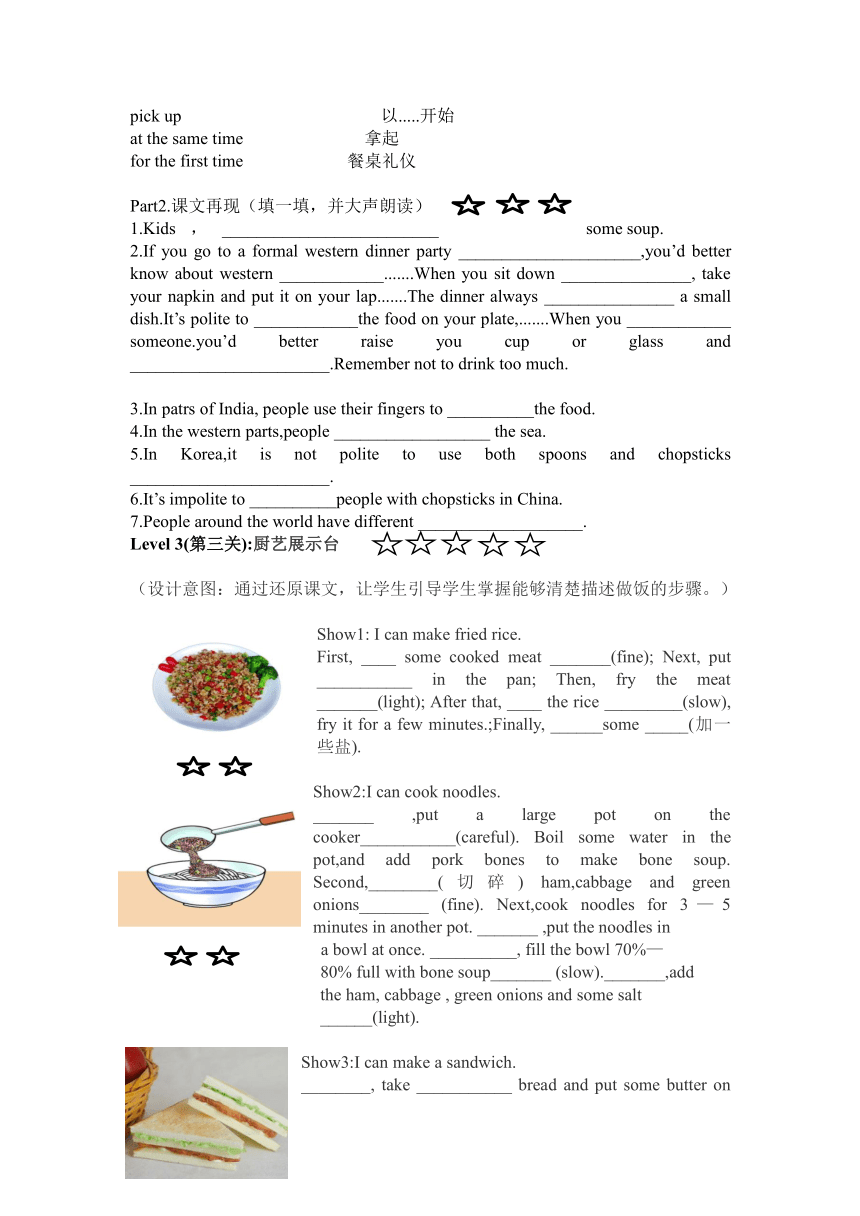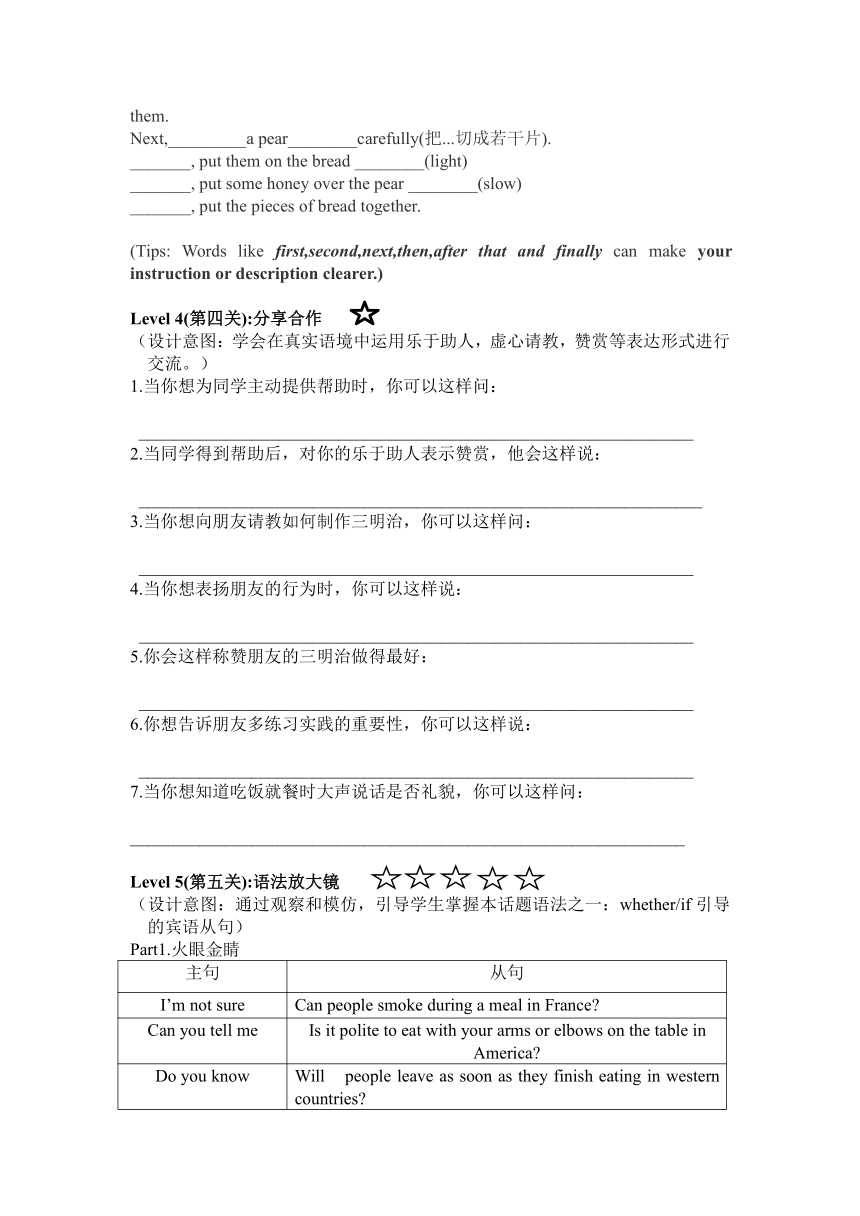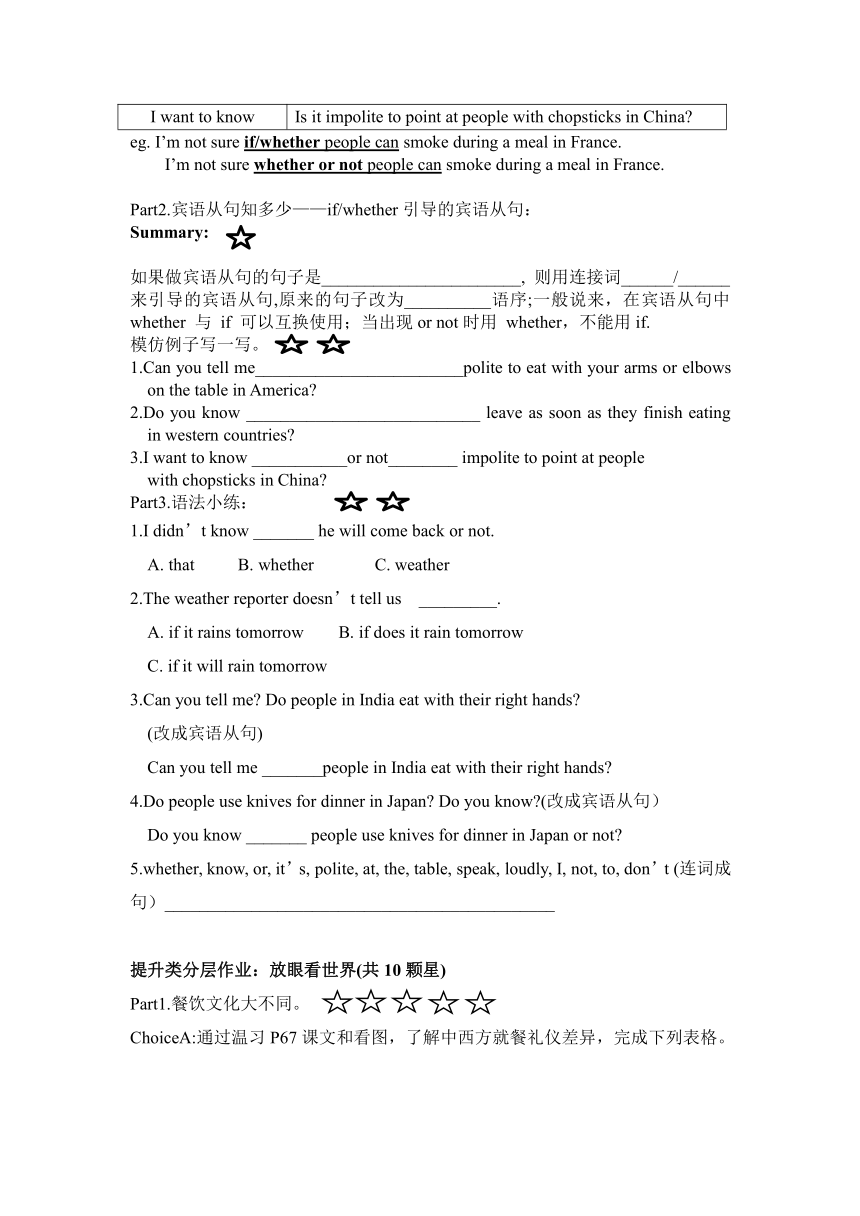Unit7 Food festival Topic 2作业设计(含答案)仁爱科普版英语八年级下册
文档属性
| 名称 | Unit7 Food festival Topic 2作业设计(含答案)仁爱科普版英语八年级下册 |

|
|
| 格式 | docx | ||
| 文件大小 | 3.0MB | ||
| 资源类型 | 教案 | ||
| 版本资源 | 仁爱科普版 | ||
| 科目 | 英语 | ||
| 更新时间 | 2025-03-10 13:43:28 | ||
图片预览





文档简介
仁爱英语教材八年级下册Unit 7 Topic 2 作业设计
Introduction(引言):北京国际学校的同学们正在热火朝天为美食节的顺利举办做准备。他们利用课余时间学做不同国家的各种美食。他们虚心请教,努力尝试的精神值得我们学习!你想做或者会做什么美食呢?一起来为美食节出一份力吧!
同学们,下列作业中每一关都设有5颗小星星( ),每闯一关都有机会点亮这些小星星哦。点亮的星星越多,你的知识宝藏越丰富。
(温馨提示:记得把得星数汇总到评价表中去哦!快来挑战吧,看看自己有多棒)
基础类作业:
Level 1(第一关):单词拼读我能行( )
(设计意图:检查学生对本话题四会词的掌握情况;引导学生通过音,形,义,构词法,对单词进行整理分类等方式记忆单词;让学生感知大声朗读对记忆英语单词的重要作用。)
1.根据图意,音标写出单词及其中文,并大声朗读。
[ l]_________[ nu dlz]_______[b l] ________[ t pst ks]____________( ) ( ) ( ) ( )
一双筷子_______________
[pe ]________( ) [pi s]________( ) [spu n]__________( )
一张纸_____________________
[d ]__________( ) [f k]_______( ) ['f g ]________( )
模仿秀(词性转换),并大声朗读
eg. quick—quickly happy—happily
light—_____________(轻轻地) fine—___________(微小地)
healthy—_____________(健康地) noisy—______________(吵闹地)
quiet—_______________(安静地) __________(有礼貌的)—politely
successful—______________(成功地) neat—____________(整洁地,整齐地)
regular—___________________(有规律地)
Rules:1. 形容词+__________ 副词
2.形容词(以辅音字母+y结尾):______________ 副词
3.单词分一分:写出以下单词的汉语意思,并根据音标大声朗读。
pork [p k]________ pan[p n ] ________ ham[h m]____________
onion[ nj n]________pot [p t] ________ sausage[ s s d ]__________
snack [sn k] ________lap [l p]__________butter [ b t (r)]_________
formal[ f ml]_____napkin[ n pk n]______elbow [ elb ]_______
seafood[ si fu d]______cooker[ k k (r)] ______manner[ m n (r)]____
食品类:______________________________________________________________
厨具类:_____________________________________________________________
其 他:______________________________________________________________ Level 2(第二关):短语闯关
(设计意图:检查学生对课文重要短语的记忆;将短语还原句中,引导学生感知在真实语境中记忆短语的重要性,并培养学生把短语运用在真实语境中的能力。)
Part1.连一连,并大声朗读
help yourself to. 饮食习惯
table manners 指着某人
sit down at the table 远离
start with 只喝一点点
eat up 吃光
drink to someone 第一次
take only a little 同时
point at sb. 向某人敬酒
eating habits 请随便吃(喝)....
be far away from 坐在桌旁
pick up 以.....开始
at the same time 拿起
for the first time 餐桌礼仪
Part2.课文再现(填一填,并大声朗读)
1.Kids,_________________________ some soup.
2.If you go to a formal western dinner party _____________________,you’d better know about western ____________.......When you sit down _______________, take your napkin and put it on your lap.......The dinner always _______________ a small dish.It’s polite to ____________the food on your plate,.......When you ____________ someone.you’d better raise you cup or glass and _______________________.Remember not to drink too much.
3.In patrs of India, people use their fingers to __________the food.
4.In the western parts,people __________________ the sea.
5.In Korea,it is not polite to use both spoons and chopsticks _______________________.
6.It’s impolite to __________people with chopsticks in China.
7.People around the world have different ___________________.
Level 3(第三关):厨艺展示台
(设计意图:通过还原课文,让学生引导学生掌握能够清楚描述做饭的步骤。)
Show1: I can make fried rice.
First, ____ some cooked meat _______(fine); Next, put ___________ in the pan; Then, fry the meat _______(light); After that, ____ the rice _________(slow), fry it for a few minutes.;Finally, ______some _____(加一些盐).
Show2:I can cook noodles.
_______ ,put a large pot on the cooker___________(careful). Boil some water in the pot,and add pork bones to make bone soup. Second,________(切碎) ham,cabbage and green onions________ (fine). Next,cook noodles for 3—5 minutes in another pot. _______ ,put the noodles in
a bowl at once. __________, fill the bowl 70%—
80% full with bone soup_______ (slow)._______,add
the ham, cabbage , green onions and some salt
______(light).
Show3:I can make a sandwich.
________, take ___________ bread and put some butter on them.
Next,_________a pear________carefully(把...切成若干片).
_______, put them on the bread ________(light)
_______, put some honey over the pear ________(slow)
_______, put the pieces of bread together.
(Tips: Words like first,second,next,then,after that and finally can make your instruction or description clearer.)
Level 4(第四关):分享合作
(设计意图:学会在真实语境中运用乐于助人,虚心请教,赞赏等表达形式进行交流。)
1.当你想为同学主动提供帮助时,你可以这样问:
________________________________________________________________
2.当同学得到帮助后,对你的乐于助人表示赞赏,他会这样说:
_________________________________________________________________
3.当你想向朋友请教如何制作三明治,你可以这样问:
________________________________________________________________
4.当你想表扬朋友的行为时,你可以这样说:
________________________________________________________________
5.你会这样称赞朋友的三明治做得最好:
________________________________________________________________
6.你想告诉朋友多练习实践的重要性,你可以这样说:
________________________________________________________________
7.当你想知道吃饭就餐时大声说话是否礼貌,你可以这样问:
________________________________________________________________
Level 5(第五关):语法放大镜
(设计意图:通过观察和模仿,引导学生掌握本话题语法之一:whether/if引导的宾语从句)
Part1.火眼金睛
主句 从句
I’m not sure Can people smoke during a meal in France
Can you tell me Is it polite to eat with your arms or elbows on the table in America
Do you know Will people leave as soon as they finish eating in western countries
I want to know Is it impolite to point at people with chopsticks in China
eg. I’m not sure if/whether people can smoke during a meal in France.
I’m not sure whether or not people can smoke during a meal in France.
Part2.宾语从句知多少——if/whether引导的宾语从句:
Summary:
如果做宾语从句的句子是_______________________, 则用连接词______/______来引导的宾语从句,原来的句子改为__________语序;一般说来,在宾语从句中 whether 与 if 可以互换使用;当出现or not时用 whether,不能用if.
模仿例子写一写。
1.Can you tell me________________________polite to eat with your arms or elbows on the table in America
2.Do you know ___________________________ leave as soon as they finish eating in western countries
3.I want to know ___________or not________ impolite to point at people
with chopsticks in China
Part3.语法小练:
1.I didn’t know _______ he will come back or not.
A. that B. whether C. weather
2.The weather reporter doesn’t tell us _________.
A. if it rains tomorrow B. if does it rain tomorrow
C. if it will rain tomorrow
3.Can you tell me Do people in India eat with their right hands
(改成宾语从句)
Can you tell me _______people in India eat with their right hands
4.Do people use knives for dinner in Japan Do you know (改成宾语从句)
Do you know _______ people use knives for dinner in Japan or not
5.whether, know, or, it’s, polite, at, the, table, speak, loudly, I, not, to, don’t (连词成句)_____________________________________________
提升类分层作业:放眼看世界(共10颗星)
Part1.餐饮文化大不同。
ChoiceA:通过温习P67课文和看图,了解中西方就餐礼仪差异,完成下列表格。
(设计意图:通过课内知识与课外知识的结合,给基础较薄弱的学生予“脚手架”,引导学生乐于接触并了解异国文化,培养学生跨文化交际意识和能力,从而提高其学习英语积极性。)
图1 图2 图3 图4
Western table manners Chinese table manners
polite ___________(吃光) the food on the plate. 图1:It’s polite to let the elder _____________(就坐)and eat first.
Try to _____________(小声说话) and ___________(多微笑) _____________(保持安静) when chewing the food.
When you _________(向......敬酒)someone,only________________(喝一点) _________(拾起)the food that is close to your seat on the plate with chopsticks
impolite Don’t take more food than you need. 图2:Hit the ______(碗)with chopsticks
Don’t drink too much 图3:____________(大声喧哗)when eating
图4:stick the chopsticks in the rice.(把筷子插入米饭里)
ChoiceB:通过温习P67课文和看图,根据关键词提示,用所学的宾语从句和课堂内外收集的信息,写一篇有关中西方就餐礼仪差异的短文。
(设计意图:通过课堂内情境的交融,提供表格信息和参考句型,让基础较好的学生在写作中有结构性导向,培养学生跨文化交际意识和能力,增强学习英语自信心,在英语学习中不断进步。
the elder, sit hit,with make noise ,when stick...in(把...插入)
图1 图2 图3 图4
Western table manners Chinese table manners
polite 吃光盘中的食物。 _____________________________ 图1: _________________________ _______________________________
尽量小声说话,多微笑 ______________________________ _____________(保持安静) when chewing(咀嚼) the food.
向别人敬酒时,只喝一点 _____________________________________________________________ _________(拾起)the food that is close to your seat on the plate with chopsticks
impolite 不要拿过多的食物。 ______________________________ 图2:___________________________ ________________________________
不要喝得过多。_________________ 图3:___________________________
图4:____________________________ _________________________________
You can begin like this :
Different countries have their own table manners.
In western countries,..........
In China,..........
Part2.饮食习惯大不同:复述课文。
Choice A:温习课本P69的Part1课文,完成以下填空。
People_________________(全世界) have ___________________________(不同的饮食习惯).In North America,Australia and Europe,people use _____________(刀叉)to eat two or three courses for every meal.In China,people____________________(使用筷子吃东西).People in the southern part __________________(常吃大米) ,while
People in the north often ____________(吃面条).People in the central and western parts don’t ______________(常吃海鲜),because they ______________(远离)海边.In parts of India,people ____________________(用手指抓食物吃).In Thailand ,people eat__________________(用汤勺和叉子)instead of using knives.In Korea, people_______________(用汤勺或筷子吃),but it is ____________(不礼貌的)
To use __________(它们两个)________________________(同时).
Choice B:温习课本P69的Part1课文,根据表格提示,完成课文复述。
Eating Habits
Where What to eat How to eat Why
North American,Australia,Europe Two or more courses for every meal knives and forks
China South Rice chopsticks
North noodles
The central and western parts Not eat seafood Be far away from the sea
India fingers
Thailand A spoon and a fork
Korea spoons or chopsticks
实践类分层作业:劳动最快乐
(设计意图:引导学生学以致用,将课文所学进行迁移创新到实际生活中,并结合“劳育”,积极培养各种生活技能,如做饭,让学生感知劳动的重要性和英语的实用性。)
ChoiceA: 和康康一起学习做炒饭或与Micheal学习制作三明治,用英语讲解制作过程,并拍成视频。
ChoiceB: 利用周末时间,和爸爸妈妈一起制作春卷(spring roll)。用英语记录并讲解制作春卷的过程,并拍成视频。(以下烹饪方法仅供参考)
Topic2作业评价表
(第1-5关)基础类作业(共25颗星)
25-20颗星 19-15颗星 14-10颗星 10颗星以下
Excellent good Not bad Try hard
A B+ B C
基础类作业: 颗星/等级:
提升类分层作业(共10颗星)
分层 10-8颗星 7-5颗星 5-3颗星 2-1颗星
Excellent good Not bad Try hard
A B+ B C
ChoiceA
ChoiceB
提升类作业 得星数/等级:
实践类分层作业(共5颗星)
5颗星 4颗星 3-2颗星 1颗星
Excellent good Not bad Try hard
A B+ B C
ChoiceA B
ChoiceB
实践类作业 得星数/等级:
作业总评: 颗星/等级:
Unit7 Topic2 参考答案
Level1.
1.oil 油noodles面条 bowl 碗chopsticks筷子 a pair of chopsticks
Pear梨 piece片,张 a piece of paper
spoon 勺子 dish盘,碟 fork 叉子finger 手指
2. lightly finely healthily noisily quietly
polite successfully neatly regularly
Rules:1. 形容词+ ly 副词
2.形容词(以辅音字母+y结尾):变y 为ily 副词
3.猪肉 平底锅 火腿
洋葱 锅 ,壶 香肠
小吃 膝部 黄油
正式的 餐巾 肘部
海鲜 厨具 方式,举止
食品类:pork ham onion sausage snack butter seafood
厨具类:pan pot cooker
其他类:lap formal napkin elbow manner
Level2
Part1: 连一连
help yourself to. 请随便吃(喝)....
table manners 餐桌礼仪
sit down at the table 坐在桌旁
start with 以.....开始
eat up 吃光
drink to someone 向某人敬酒
take only a little 只喝一点点
point at sb. 指着某人
eating habits 饮食习惯
be far away from 远离
pick up 拿起
at the same time 同时
for the first time 第一次
Part2.课文再现(填一填)
1. Help yourselves to.
2. for the fitst time ; table manners ;at the table;
start with; eat up; drink to; take only a little
3.pick up
4.are far away from
5. at the same time
6. point at
7. eating habits
Level3
Show1:cut, finley ,some oil, lightly, add. slowly, add, salt
Show2:First, carefully, cut up, finely, Then, After that, slowly, Finally, lightly
Show3:First, two pieces of ,cut,into small pieces , Then, lightly, After all, slowly, Finally
Level4
May I help you / What can I do for you
It’s very kind of you .
Would you mind teaching me to make the sandwich /
Can you tell me how to make the sandwich
Well done./ You did very well.
You made the sandwich best of all.
Practice makes perfect.
Can you tell me if it’s polite to speak loudly at the table
Level5.
Part2:一般疑问句,if/whether,陈述句
if/whether it is
if/whether people will
whether it is
Part3.
1.B 2. C 3. if/whether 4. whether
5. I don’t know whether or not it’s polite to speak loudly at the table.
提升类分层作业:
Part1: ChoiceA
Western table manners Chinese table manners
polite Eat up(吃光) the food on the plate. 图1:It’s polite to let the elder take a seat / sit(就坐)and eat first.
Try to speak quietly(小声说话) and smile a lot(多微笑) Keep quiet (保持安静) when chewing the food.
When you drink to (向......敬酒)someone, only take only a little(喝一点) Pick up(拾起)the food that is close to your seat on the plate with chopsticks
impolite Don’t take more food than you need. 图2:Hit the bowl(碗)with chopsticks
Don’t drink too much 图3:Speak noisily(大声喧哗)when eating
图4:stick the chopsticks in the rice.(把筷子插入米饭里)
ChoiceB
Western table manners Chinese table manners
polite 吃光盘中的食物。 Eat up the food in the plate. 图1: It’s polite to let the elder take a seat / sit and eat first.
尽量小声说话,多微笑 Try to speak quietly and smile a lot Keep quiet when chewing(咀嚼) the food.
向别人敬酒时,只喝一点 When you drink to someone, only take only a little Pick up the food that is close to your seat on the plate with chopsticks
impolite 不要拿过多的食物。 Don’t take more food than you need. 图2:Hit the bowl with chopsticks
不要喝得过多。 Don’t drink too much 图3:Speak noisily when eating
图4:stick the chopsticks in the rice.
PartB:
ChoiceA:
all over the world, different eating habits; knives and forks; use chopsticks to eat; eat rice a lot; eat noodles; eat much seafood; are far away from; use fingers to pick up ;a spoon and a fork; use spoons or chopsticks to eat; impolite ,both of them ,at the same time.
ChoiceB:口头表达作业(略)
实践类分层作业:(略)
Introduction(引言):北京国际学校的同学们正在热火朝天为美食节的顺利举办做准备。他们利用课余时间学做不同国家的各种美食。他们虚心请教,努力尝试的精神值得我们学习!你想做或者会做什么美食呢?一起来为美食节出一份力吧!
同学们,下列作业中每一关都设有5颗小星星( ),每闯一关都有机会点亮这些小星星哦。点亮的星星越多,你的知识宝藏越丰富。
(温馨提示:记得把得星数汇总到评价表中去哦!快来挑战吧,看看自己有多棒)
基础类作业:
Level 1(第一关):单词拼读我能行( )
(设计意图:检查学生对本话题四会词的掌握情况;引导学生通过音,形,义,构词法,对单词进行整理分类等方式记忆单词;让学生感知大声朗读对记忆英语单词的重要作用。)
1.根据图意,音标写出单词及其中文,并大声朗读。
[ l]_________[ nu dlz]_______[b l] ________[ t pst ks]____________( ) ( ) ( ) ( )
一双筷子_______________
[pe ]________( ) [pi s]________( ) [spu n]__________( )
一张纸_____________________
[d ]__________( ) [f k]_______( ) ['f g ]________( )
模仿秀(词性转换),并大声朗读
eg. quick—quickly happy—happily
light—_____________(轻轻地) fine—___________(微小地)
healthy—_____________(健康地) noisy—______________(吵闹地)
quiet—_______________(安静地) __________(有礼貌的)—politely
successful—______________(成功地) neat—____________(整洁地,整齐地)
regular—___________________(有规律地)
Rules:1. 形容词+__________ 副词
2.形容词(以辅音字母+y结尾):______________ 副词
3.单词分一分:写出以下单词的汉语意思,并根据音标大声朗读。
pork [p k]________ pan[p n ] ________ ham[h m]____________
onion[ nj n]________pot [p t] ________ sausage[ s s d ]__________
snack [sn k] ________lap [l p]__________butter [ b t (r)]_________
formal[ f ml]_____napkin[ n pk n]______elbow [ elb ]_______
seafood[ si fu d]______cooker[ k k (r)] ______manner[ m n (r)]____
食品类:______________________________________________________________
厨具类:_____________________________________________________________
其 他:______________________________________________________________ Level 2(第二关):短语闯关
(设计意图:检查学生对课文重要短语的记忆;将短语还原句中,引导学生感知在真实语境中记忆短语的重要性,并培养学生把短语运用在真实语境中的能力。)
Part1.连一连,并大声朗读
help yourself to. 饮食习惯
table manners 指着某人
sit down at the table 远离
start with 只喝一点点
eat up 吃光
drink to someone 第一次
take only a little 同时
point at sb. 向某人敬酒
eating habits 请随便吃(喝)....
be far away from 坐在桌旁
pick up 以.....开始
at the same time 拿起
for the first time 餐桌礼仪
Part2.课文再现(填一填,并大声朗读)
1.Kids,_________________________ some soup.
2.If you go to a formal western dinner party _____________________,you’d better know about western ____________.......When you sit down _______________, take your napkin and put it on your lap.......The dinner always _______________ a small dish.It’s polite to ____________the food on your plate,.......When you ____________ someone.you’d better raise you cup or glass and _______________________.Remember not to drink too much.
3.In patrs of India, people use their fingers to __________the food.
4.In the western parts,people __________________ the sea.
5.In Korea,it is not polite to use both spoons and chopsticks _______________________.
6.It’s impolite to __________people with chopsticks in China.
7.People around the world have different ___________________.
Level 3(第三关):厨艺展示台
(设计意图:通过还原课文,让学生引导学生掌握能够清楚描述做饭的步骤。)
Show1: I can make fried rice.
First, ____ some cooked meat _______(fine); Next, put ___________ in the pan; Then, fry the meat _______(light); After that, ____ the rice _________(slow), fry it for a few minutes.;Finally, ______some _____(加一些盐).
Show2:I can cook noodles.
_______ ,put a large pot on the cooker___________(careful). Boil some water in the pot,and add pork bones to make bone soup. Second,________(切碎) ham,cabbage and green onions________ (fine). Next,cook noodles for 3—5 minutes in another pot. _______ ,put the noodles in
a bowl at once. __________, fill the bowl 70%—
80% full with bone soup_______ (slow)._______,add
the ham, cabbage , green onions and some salt
______(light).
Show3:I can make a sandwich.
________, take ___________ bread and put some butter on them.
Next,_________a pear________carefully(把...切成若干片).
_______, put them on the bread ________(light)
_______, put some honey over the pear ________(slow)
_______, put the pieces of bread together.
(Tips: Words like first,second,next,then,after that and finally can make your instruction or description clearer.)
Level 4(第四关):分享合作
(设计意图:学会在真实语境中运用乐于助人,虚心请教,赞赏等表达形式进行交流。)
1.当你想为同学主动提供帮助时,你可以这样问:
________________________________________________________________
2.当同学得到帮助后,对你的乐于助人表示赞赏,他会这样说:
_________________________________________________________________
3.当你想向朋友请教如何制作三明治,你可以这样问:
________________________________________________________________
4.当你想表扬朋友的行为时,你可以这样说:
________________________________________________________________
5.你会这样称赞朋友的三明治做得最好:
________________________________________________________________
6.你想告诉朋友多练习实践的重要性,你可以这样说:
________________________________________________________________
7.当你想知道吃饭就餐时大声说话是否礼貌,你可以这样问:
________________________________________________________________
Level 5(第五关):语法放大镜
(设计意图:通过观察和模仿,引导学生掌握本话题语法之一:whether/if引导的宾语从句)
Part1.火眼金睛
主句 从句
I’m not sure Can people smoke during a meal in France
Can you tell me Is it polite to eat with your arms or elbows on the table in America
Do you know Will people leave as soon as they finish eating in western countries
I want to know Is it impolite to point at people with chopsticks in China
eg. I’m not sure if/whether people can smoke during a meal in France.
I’m not sure whether or not people can smoke during a meal in France.
Part2.宾语从句知多少——if/whether引导的宾语从句:
Summary:
如果做宾语从句的句子是_______________________, 则用连接词______/______来引导的宾语从句,原来的句子改为__________语序;一般说来,在宾语从句中 whether 与 if 可以互换使用;当出现or not时用 whether,不能用if.
模仿例子写一写。
1.Can you tell me________________________polite to eat with your arms or elbows on the table in America
2.Do you know ___________________________ leave as soon as they finish eating in western countries
3.I want to know ___________or not________ impolite to point at people
with chopsticks in China
Part3.语法小练:
1.I didn’t know _______ he will come back or not.
A. that B. whether C. weather
2.The weather reporter doesn’t tell us _________.
A. if it rains tomorrow B. if does it rain tomorrow
C. if it will rain tomorrow
3.Can you tell me Do people in India eat with their right hands
(改成宾语从句)
Can you tell me _______people in India eat with their right hands
4.Do people use knives for dinner in Japan Do you know (改成宾语从句)
Do you know _______ people use knives for dinner in Japan or not
5.whether, know, or, it’s, polite, at, the, table, speak, loudly, I, not, to, don’t (连词成句)_____________________________________________
提升类分层作业:放眼看世界(共10颗星)
Part1.餐饮文化大不同。
ChoiceA:通过温习P67课文和看图,了解中西方就餐礼仪差异,完成下列表格。
(设计意图:通过课内知识与课外知识的结合,给基础较薄弱的学生予“脚手架”,引导学生乐于接触并了解异国文化,培养学生跨文化交际意识和能力,从而提高其学习英语积极性。)
图1 图2 图3 图4
Western table manners Chinese table manners
polite ___________(吃光) the food on the plate. 图1:It’s polite to let the elder _____________(就坐)and eat first.
Try to _____________(小声说话) and ___________(多微笑) _____________(保持安静) when chewing the food.
When you _________(向......敬酒)someone,only________________(喝一点) _________(拾起)the food that is close to your seat on the plate with chopsticks
impolite Don’t take more food than you need. 图2:Hit the ______(碗)with chopsticks
Don’t drink too much 图3:____________(大声喧哗)when eating
图4:stick the chopsticks in the rice.(把筷子插入米饭里)
ChoiceB:通过温习P67课文和看图,根据关键词提示,用所学的宾语从句和课堂内外收集的信息,写一篇有关中西方就餐礼仪差异的短文。
(设计意图:通过课堂内情境的交融,提供表格信息和参考句型,让基础较好的学生在写作中有结构性导向,培养学生跨文化交际意识和能力,增强学习英语自信心,在英语学习中不断进步。
the elder, sit hit,with make noise ,when stick...in(把...插入)
图1 图2 图3 图4
Western table manners Chinese table manners
polite 吃光盘中的食物。 _____________________________ 图1: _________________________ _______________________________
尽量小声说话,多微笑 ______________________________ _____________(保持安静) when chewing(咀嚼) the food.
向别人敬酒时,只喝一点 _____________________________________________________________ _________(拾起)the food that is close to your seat on the plate with chopsticks
impolite 不要拿过多的食物。 ______________________________ 图2:___________________________ ________________________________
不要喝得过多。_________________ 图3:___________________________
图4:____________________________ _________________________________
You can begin like this :
Different countries have their own table manners.
In western countries,..........
In China,..........
Part2.饮食习惯大不同:复述课文。
Choice A:温习课本P69的Part1课文,完成以下填空。
People_________________(全世界) have ___________________________(不同的饮食习惯).In North America,Australia and Europe,people use _____________(刀叉)to eat two or three courses for every meal.In China,people____________________(使用筷子吃东西).People in the southern part __________________(常吃大米) ,while
People in the north often ____________(吃面条).People in the central and western parts don’t ______________(常吃海鲜),because they ______________(远离)海边.In parts of India,people ____________________(用手指抓食物吃).In Thailand ,people eat__________________(用汤勺和叉子)instead of using knives.In Korea, people_______________(用汤勺或筷子吃),but it is ____________(不礼貌的)
To use __________(它们两个)________________________(同时).
Choice B:温习课本P69的Part1课文,根据表格提示,完成课文复述。
Eating Habits
Where What to eat How to eat Why
North American,Australia,Europe Two or more courses for every meal knives and forks
China South Rice chopsticks
North noodles
The central and western parts Not eat seafood Be far away from the sea
India fingers
Thailand A spoon and a fork
Korea spoons or chopsticks
实践类分层作业:劳动最快乐
(设计意图:引导学生学以致用,将课文所学进行迁移创新到实际生活中,并结合“劳育”,积极培养各种生活技能,如做饭,让学生感知劳动的重要性和英语的实用性。)
ChoiceA: 和康康一起学习做炒饭或与Micheal学习制作三明治,用英语讲解制作过程,并拍成视频。
ChoiceB: 利用周末时间,和爸爸妈妈一起制作春卷(spring roll)。用英语记录并讲解制作春卷的过程,并拍成视频。(以下烹饪方法仅供参考)
Topic2作业评价表
(第1-5关)基础类作业(共25颗星)
25-20颗星 19-15颗星 14-10颗星 10颗星以下
Excellent good Not bad Try hard
A B+ B C
基础类作业: 颗星/等级:
提升类分层作业(共10颗星)
分层 10-8颗星 7-5颗星 5-3颗星 2-1颗星
Excellent good Not bad Try hard
A B+ B C
ChoiceA
ChoiceB
提升类作业 得星数/等级:
实践类分层作业(共5颗星)
5颗星 4颗星 3-2颗星 1颗星
Excellent good Not bad Try hard
A B+ B C
ChoiceA B
ChoiceB
实践类作业 得星数/等级:
作业总评: 颗星/等级:
Unit7 Topic2 参考答案
Level1.
1.oil 油noodles面条 bowl 碗chopsticks筷子 a pair of chopsticks
Pear梨 piece片,张 a piece of paper
spoon 勺子 dish盘,碟 fork 叉子finger 手指
2. lightly finely healthily noisily quietly
polite successfully neatly regularly
Rules:1. 形容词+ ly 副词
2.形容词(以辅音字母+y结尾):变y 为ily 副词
3.猪肉 平底锅 火腿
洋葱 锅 ,壶 香肠
小吃 膝部 黄油
正式的 餐巾 肘部
海鲜 厨具 方式,举止
食品类:pork ham onion sausage snack butter seafood
厨具类:pan pot cooker
其他类:lap formal napkin elbow manner
Level2
Part1: 连一连
help yourself to. 请随便吃(喝)....
table manners 餐桌礼仪
sit down at the table 坐在桌旁
start with 以.....开始
eat up 吃光
drink to someone 向某人敬酒
take only a little 只喝一点点
point at sb. 指着某人
eating habits 饮食习惯
be far away from 远离
pick up 拿起
at the same time 同时
for the first time 第一次
Part2.课文再现(填一填)
1. Help yourselves to.
2. for the fitst time ; table manners ;at the table;
start with; eat up; drink to; take only a little
3.pick up
4.are far away from
5. at the same time
6. point at
7. eating habits
Level3
Show1:cut, finley ,some oil, lightly, add. slowly, add, salt
Show2:First, carefully, cut up, finely, Then, After that, slowly, Finally, lightly
Show3:First, two pieces of ,cut,into small pieces , Then, lightly, After all, slowly, Finally
Level4
May I help you / What can I do for you
It’s very kind of you .
Would you mind teaching me to make the sandwich /
Can you tell me how to make the sandwich
Well done./ You did very well.
You made the sandwich best of all.
Practice makes perfect.
Can you tell me if it’s polite to speak loudly at the table
Level5.
Part2:一般疑问句,if/whether,陈述句
if/whether it is
if/whether people will
whether it is
Part3.
1.B 2. C 3. if/whether 4. whether
5. I don’t know whether or not it’s polite to speak loudly at the table.
提升类分层作业:
Part1: ChoiceA
Western table manners Chinese table manners
polite Eat up(吃光) the food on the plate. 图1:It’s polite to let the elder take a seat / sit(就坐)and eat first.
Try to speak quietly(小声说话) and smile a lot(多微笑) Keep quiet (保持安静) when chewing the food.
When you drink to (向......敬酒)someone, only take only a little(喝一点) Pick up(拾起)the food that is close to your seat on the plate with chopsticks
impolite Don’t take more food than you need. 图2:Hit the bowl(碗)with chopsticks
Don’t drink too much 图3:Speak noisily(大声喧哗)when eating
图4:stick the chopsticks in the rice.(把筷子插入米饭里)
ChoiceB
Western table manners Chinese table manners
polite 吃光盘中的食物。 Eat up the food in the plate. 图1: It’s polite to let the elder take a seat / sit and eat first.
尽量小声说话,多微笑 Try to speak quietly and smile a lot Keep quiet when chewing(咀嚼) the food.
向别人敬酒时,只喝一点 When you drink to someone, only take only a little Pick up the food that is close to your seat on the plate with chopsticks
impolite 不要拿过多的食物。 Don’t take more food than you need. 图2:Hit the bowl with chopsticks
不要喝得过多。 Don’t drink too much 图3:Speak noisily when eating
图4:stick the chopsticks in the rice.
PartB:
ChoiceA:
all over the world, different eating habits; knives and forks; use chopsticks to eat; eat rice a lot; eat noodles; eat much seafood; are far away from; use fingers to pick up ;a spoon and a fork; use spoons or chopsticks to eat; impolite ,both of them ,at the same time.
ChoiceB:口头表达作业(略)
实践类分层作业:(略)
同课章节目录
- Unit 5 Feeling excited
- Topic 1 You look excited
- Topic 2 I’m feeling better now.
- Topic 3 Many things can affect our feelings.
- Unit 6 Enjoying Cycling
- Topic 1 We're going on a three-day visit to Mount
- Topic 2 How about exploring Tian’anmen Square?
- Topic 3 Bicycle riding is good exercise.
- Unit 7 Food festival
- Topic 1 We’re preparing for a food festival.
- Topic 2 I’m not sure whether I can cook it well.
- Topic 3 I Cooked the Most Successfully
- Unit 8 Our Clothes
- Topic 1 We will have a class fashion show.
- Topic 2 We can design our own uniforms.
- Topic 3 He said the fashion show was wonderful.
